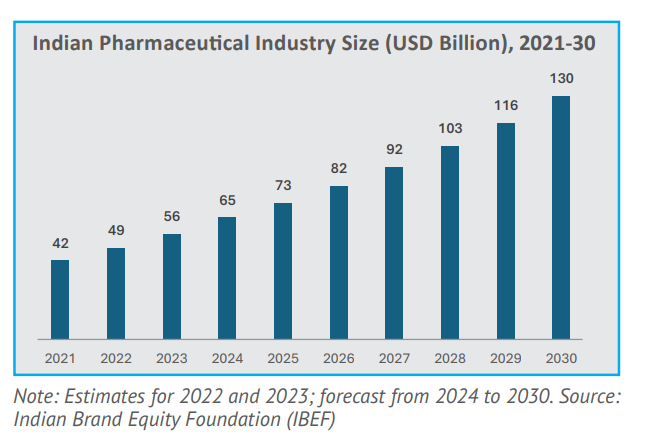Written by : Nikita Saha
June 20, 2024

The study reveals that the United States emerges as the largest buyer of Indian pharmaceuticals, accounting for almost 30% of these exports.
In a robust display of sustained growth, the Indian pharmaceutical industry is projected to hit a market size of $130 billion by 2030, according to a recent report by Rubix Data Sciences.
Per the report, the industry is set to maintain a double-digit growth trajectory with a Compound Annual Growth Rate (CAGR) of 12%.

Further, the report revealed, India's dominance in the generic medicines sector is a significant driver of this growth. The country is the world's largest supplier of generic medicines, contributing to 20% of the global supply by volume.
Sharing thoughts, Avinash Kumar Talwar, VP, Dr Reddy’s Laboratories, said, “As the growth of the pharma market is coming from complex molecules, it will force companies to invest and build future state-of-the-art labs. The demand for sophisticated equipment and instruments to aid in the process of drug discovery, development, analysis and modelling of the compounds will continue to grow at the same pace.”
Additionally, India fulfills approximately 60% of the global demand for vaccines. With nearly 50% of its pharmaceutical production being exported, India's pharma exports are essential to the industry’s overall size and health.

Moreover, the report noted that the United States emerges as the largest buyer of Indian pharmaceuticals, accounting for almost 30% of these exports.
While Indian medicines reach over 200 countries, showcasing a diversified export market that bolsters India’s standing as a key player in global healthcare.
However, the industry's reliance on China for bulk drugs presents a critical challenge.
Nearly 72% of India’s bulk drug imports by value in FY24 came from China, highlighting a significant dependency despite government efforts to promote domestic production.

To address this vulnerability, the Indian government has implemented several initiatives. Programs such as the Production Linked Incentive (PLI) scheme and the revamped Pharmaceutical Technology Upgradation Assistance Scheme (PTUAS) aim to enhance domestic manufacturing capabilities.
Additionally, the establishment of bulk drug parks is a strategic move to reduce dependency on Chinese imports. Despite these efforts, the industry continues to grapple with the challenge of ensuring global quality standards and compliance, the study observed.
The report highlighted the necessity for heightened vigilance in maintaining quality, especially with increased scrutiny from the US FDA. The problem of counterfeit drugs in India further necessitates stringent quality control measures to uphold the integrity of the Indian pharmaceutical industry.
According to the Rubic study, the expiration of patents for drugs with a market size of $251 billion by 2030 presents a lucrative opportunity for Indian generic manufacturers to strengthen their position in the US market.

Domestically, the growth of medical tourism, the rise of e-pharmacies, and the expansion of health insurance coverage are expected to drive industry growth.
Factors such as rising per capita income, increased public awareness, access to healthcare services, and government initiatives including the Pradhan Mantri Jan Arogya Yojana (PM-JAY) have significantly contributed to this growth.
Moreover, the industry’s cost advantages further cement its competitive edge. Manufacturing costs in India are 30%–35% lower than in the US and Europe, and labor costs are 60%–70% lower.
These factors, coupled with cost-efficient R&D, make India an attractive hub for pharmaceutical production, noted the latest Rubic Data Sciences report.
“Indian drug-makers need to step up focus on research and innovation in fast-changing global market realities where countries like Bangladesh and Vietnam are emerging as significant players,” stated R Uday Bhaskar, director general, Pharmaceuticals Export Promotion Council of India [Pharmexcil].
Despite facing challenges such as price corrections in the US market due to the consolidation of buyers and distributors in the generics segment, India’s share in the US pharma export market has remained steady since FY17.
As the Indian pharmaceutical industry marches towards the $130 billion mark by 2030, it remains a cornerstone of global healthcare. With continued government support and industry vigilance, India is well-positioned to reinforce its status as the “Pharmacy of the World.”
Rubix Data Sciences report provides an in-depth analysis of the current market dynamics, future growth prospects, and the strategic initiatives required to maintain India's leadership position in the global pharmaceutical market.